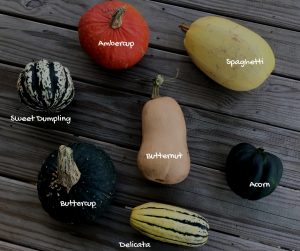We often get asked at market about the fall squash. Everyone knows what butternut is, but what about the others? What do they taste like? Can you cook them the same?
This fall squash guide will make you feel confident enough to try them all and enjoy everything this fall favorite has to offer.
WHAT KIND OF SQUASH IS THAT?
Butternut Squash – This customer favorite features a bright orange flesh with a sweet taste. It stores well.
Acorn Squash – This squash features a sweet, nutty, mild flavored squash. Acorn squash stores well.

Buttercup Squash – Buttercup squash has a nutty earthy flavor with a touch of sweetness. Buttercup squash stores well.
Ambercup Squash – This sweet, smooth squash is a family favorite! It can be used interchangeably with pie pumpkin. It stores well.
Sweet Dumpling Squash – This squash makes a perfect bowl for cooking your meal in. It is a sweet squash also comparable to a sweet potato. It stores well.
Spaghetti Squash – By scraping the flesh of this squash you will get strings comparable to noodles. This is a great pasta alternative!
HOW TO STORE WINTER SQUASH:
Most fall squashes can keep well into the winter. Lay them out in a cool dark spot. Check them occasionally for soft spots, using those first.
HOW TO COOK WINTER SQUASH:
Bake – Cut smaller squash (like acorn squash) in half; scoop out the seeds. Place 2 teaspoons honey, brown sugar, or maple syrup and 1 tablespoon butter into their centers. Bake in a preheated 350 degrees oven for about 30 minutes, or until easily pierced with a fork.
Microwave Method – Cut the squash in half and discard seeds. Microwave on high for seven minutes per pound.
Roast – Cut in half and seed squash. Place the squash halves, cut-side up, on a rimmed baking sheet. Rub the flesh with softened butter or oil, season with salt and pepper, and drizzle with brown sugar, maple syrup, or orange juice. Flip the squash over and roast them for 40 to 45 minutes in a preheated 400 degrees Oven. Roast the squash until the skin is blistered, browned, and the flesh is tender. Insert a fork or knife under the skin to test that the flesh is tender. When the squash has cooled the skin should peel off easily.
Boil – Cut the squash in half and discard the seeds. Peel and cut the squash into chunks. Place in a saucepan and cover with water. Bring to a boil and cook until the squash is tender. Let the chunks cool, then purée the flesh in a food processor or mash. To use the purée in pies, pass it through a strainer or sieve to remove any fibers or chunks.
Side Note: Make sure to save the squash seeds! You can cook them just like pumpkin seeds for a delicious healthy snack!
HOW TO FREEZE WINTER SQUASH:
Fall squash is very easy to freeze! We typically cook a whole oven full at one time. Cut the squash in half and scoop the seeds out. Place in a pan with water in the bottom. Cover. Bake until soft and scoop out the squash. Mash until you have the consistency you like. Place in freezer containers or freezer bags.
Ready to give them try? Stop by the market at the farm or farmers markets and pick out a few kinds to try out!
